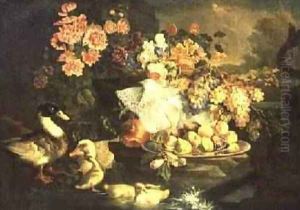Francesco Morosini Paintings
Francesco Morosini was a prominent Venetian nobleman, military leader, and statesman in the 17th century, celebrated for his role in the wars against the Ottoman Empire. Born into the illustrious Morosini family on February 26, 1619, in Venice, Italy, he was destined for a life of service to the Venetian Republic. His career is marked by significant military achievements and a tenure as the Doge of Venice, a position he held from 1688 until his death in 1694. Morosini's early life was steeped in the martial traditions of the Venetian nobility, preparing him for the military and political roles he would later assume.
Morosini first made a name for himself in the Cretan War (1645–1669), where Venice battled the Ottoman Empire for control of Crete, a conflict that ultimately ended in Venetian defeat and the loss of the strategically vital island. Despite the setback, Morosini's leadership and tactical skill earned him respect and recognition. His most notable achievements came later, during the Morean War (1684–1699), where he led the Venetian forces to significant victories against the Ottomans, notably the conquest of the Peloponnese and the capture of Athens in 1687. During the siege of Athens, artillery fire from Morosini's forces inadvertently caused severe damage to the Parthenon, which was being used by the Ottomans as a gunpowder magazine, a tragic event that has marred his legacy.
Elevated to the position of Doge of Venice in 1688, Morosini continued to focus on the conflict with the Ottoman Empire, earning the nickname 'Il Peloponnesiaco' for his conquests in the Peloponnese. His tenure as Doge was marked by ongoing military campaigns and efforts to strengthen the Venetian Republic's maritime and territorial power. However, his health began to decline during his final campaign in the Morean War, and he died on January 16, 1694, in Nafplio, Greece.
Morosini's legacy is a complex one; he is remembered both as a valiant defender of Venetian interests against the Ottoman threat and as a figure whose military actions led to the destruction of significant cultural heritage. Despite the controversies, his contributions to the Venetian Republic during a period of intense military conflict and his role in shaping the geopolitical landscape of the Eastern Mediterranean are undeniable. Morosini’s extensive collection of artworks and antiquities, amassed during his campaigns, significantly enriched Venetian cultural institutions, leaving a lasting impact on the city's artistic heritage.
